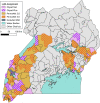This is a preprint.
LLIN Evaluation in Uganda Project (LLINEUP) - Plasmodium infection prevalence and genotypic markers of insecticide resistance in Anopheles vectors from 48 districts of Uganda
- PMID: 37577716
- PMCID: PMC10418296
- DOI: 10.1101/2023.07.31.23293323
LLIN Evaluation in Uganda Project (LLINEUP) - Plasmodium infection prevalence and genotypic markers of insecticide resistance in Anopheles vectors from 48 districts of Uganda
Update in
-
LLIN Evaluation in Uganda Project (LLINEUP)-effects of a vector control trial on Plasmodium infection prevalence and genotypic markers of insecticide resistance in Anopheles vectors from 48 districts of Uganda.Sci Rep. 2024 Jun 24;14(1):14488. doi: 10.1038/s41598-024-65050-z. Sci Rep. 2024. PMID: 38914669 Free PMC article.
Abstract
Background: In 2017-2019, we conducted a large-scale, cluster-randomised trial (LLINEUP) to evaluate long-lasting insecticidal nets (LLINs) treated with a pyrethroid insecticide plus the synergist piperonyl butoxide (PBO LLINs), as compared to conventional, pyrethroid-only LLINs across 104 health sub-districts (HSDs) in Uganda. In LLINEUP, and similar trials in Tanzania, PBO LLINs were found to provide greater protection against malaria than conventional LLINs, reducing parasitaemia and vector density. In the LLINEUP trial, cross-sectional entomological surveys were carried out at baseline and then every 6 months for two years. In each survey, ten households per HSD were randomly selected for indoor household entomological collections.
Results: Overall, 5395 female Anopheles mosquitoes were collected from 5046 households. The proportion of mosquitoes infected with Plasmodium falciparum did not change significantly over time, while infection with non-falciparum malaria decreased in An. gambiae s.s, but not An. funestus. The frequency of genetic markers associated with pyrethroid resistance increased significantly over time, but the rate of change was not different between the two LLIN types. The knock-down resistance (kdr) mutation Vgsc-995S declined over time as Vgsc-995F, the alternative resistance mutation at this codon, increased. Vgsc-995F appears to be spreading into Uganda.
Conclusions: Distribution of LLINs in Uganda was associated with reductions in parasite prevalence and vector density, but the proportion of infective mosquitoes remained stable, suggesting that the potential for transmission persisted. The increased frequency of markers of pyrethroid resistance indicates that LLIN distribution favoured the evolution of resistance within local vectors and highlights the potential benefits of resistance management strategies.Trial registration:: This study is registered with ISRCTN, ISRCTN17516395. Registered 14 February 2017, http://www.isrctn.com/ISRCTN17516395.
Keywords: Uganda; cluster-randomised trial; insecticide resistance; long-lasting insecticidal nets (LLINs); malaria; piperonyl butoxide (PBO); vector control.
Conflict of interest statement
Competing interests The authors declare that they have no competing interests.
Figures




References
-
- Abrams PA (1993) Does increased mortality favor the evolution of more rapid senescence. Evolution, 47, 877–887. - PubMed
Publication types
Grants and funding
LinkOut - more resources
Full Text Sources
